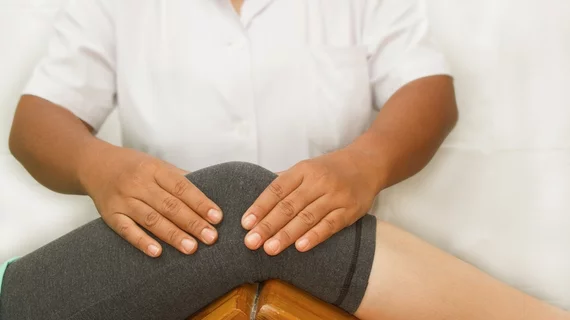Shockwaves appear to have early success in breaking up calcified lesions safely. In research presented Nov. 5 at the 2014 Vascular Interventional Advances (VIVA) meeting in Las Vegas, a lithotripsy-with-balloon technique used on peripheral artery lesions resulted in all patients achieving less than 50 percent stenosis.
The DISRUPT PAD study used Lithoplasty balloon catheters (Shockwave Medical), which combined low-pressure balloon angioplasty with a core containing the mechanical wave-emitting device. The single-arm, multicenter study enrolled 35 patients with moderate to severe calcification, more than 70 percent stenosis and lesions 3.3 to 7 mm in diameter and less than 180 mm long.
Once in place, the balloon was partially inflated, lithotripsy was activated and the shockwaves disrupted the calcification. The balloon was then fully inflated, albeit at a much lower pressure than traditional angioplasty, to dilate the vessel.
Following the procedure, patients had an average residual stenosis of 23 percent. This success was seen in both moderate and severely calcified lesions. No adverse events were reported. As this procedure did not require balloon overinflation to break up calcification, no vessel ruptures occurred. At 30 days, no restenosis was seen through ultrasound. Patients experienced improvement in clinical pain and walking scores at 30 days, as well.
Similar findings were noted in an earlier test of the device presented at the 2014 Transcatheter Cardiovascular Therapeutics conference, where lithoplasty had equal success in five patients with coronary lesions.
“The data looks really promising,” said Marianne Brodmann, MD, of Medical University of Graz in Austria, in an interview with Cardiovascular Business. “When looking at the 30-day data, vessel wall flexibility and reactivity improves to near normal.” This was an unanticipated result. She predicted the six-month data will continue to bear these findings out.
Brodmann noted that while they had expected embolization, it did not occur. “We were very surprised to see the high level of safety [with this procedure] and by the positive effect of the body’s ability to regain vessel wall activity.” It was, she suggested, due to the ability to reach deep calcium in addition to superficial calcium with the shockwave device.
Her lab plans on future studies to test whether the results of the initial study can be repeated. Further studies are also planned for other arterial areas. Brodmann also stated that while the device currently utilized a regular balloon, “In the future, a drug-coated balloon could be used to put drugs into the vessel wall.”
Brodmann said the device was user-friendly. However, “I think the proof of concept with this system is that you can go back and achieve right away reductions of stenosis less than 50 percent. We were able to see reductions down to less than 30 percent. At least in our own institution, the data looks promising at this point.”
Six month follow-up data is forthcoming.
